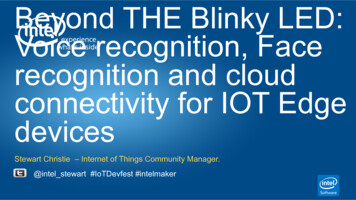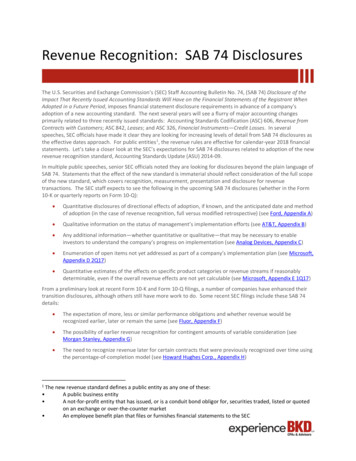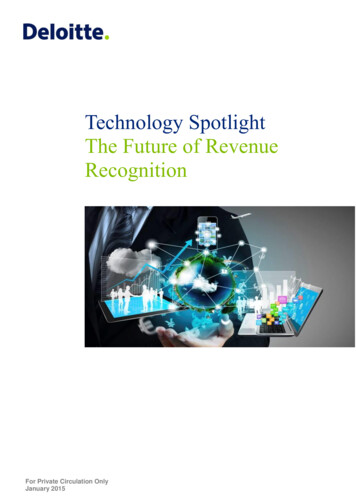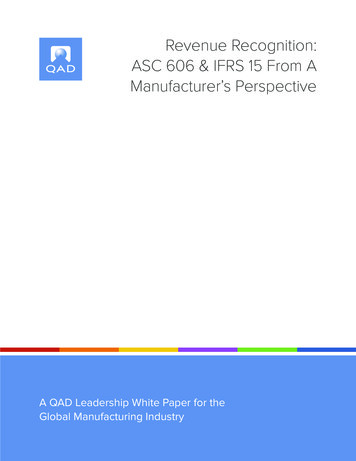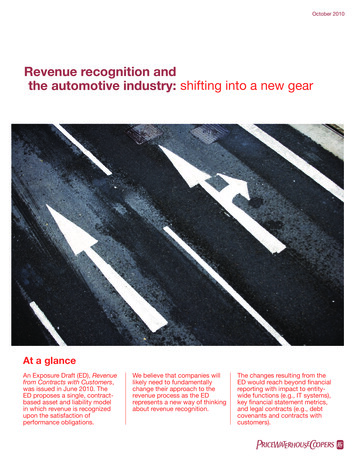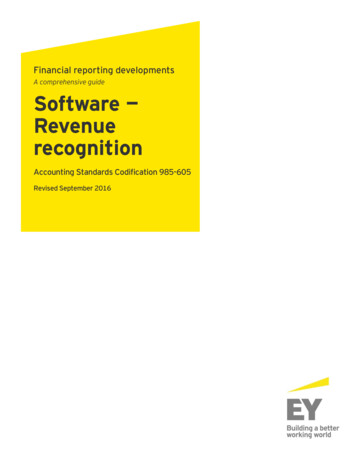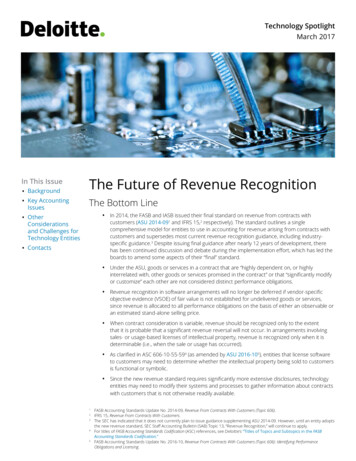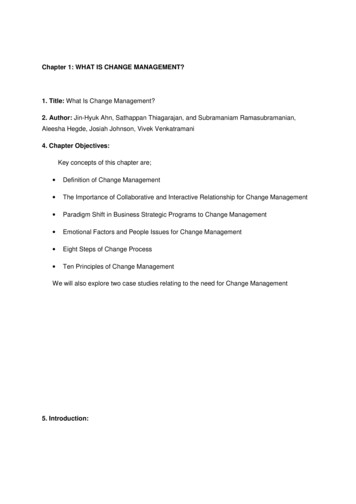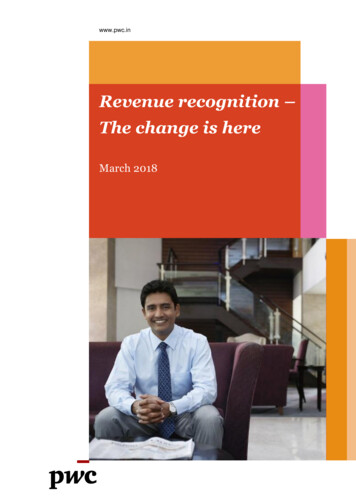
Transcription
www.pwc.inRevenue recognition –The change is hereMarch 2018
Revenue recognition - the future is hereIn May 2014, the International Accounting Standards Board (IASB) and Financial Accounting Standards Board(FASB) issued their long-awaited converged standard on revenue recognition. These standards are required tobe adopted by the IFRS and US GAAP reporters from 1 January 2018. The Ministry of Corporate Affairs (MCA)has notified Ind AS 115, 'Revenue from Contracts with Customers', on 28 March 2018, which is effective foraccounting periods beginning on or after 1 April 2018.Ind AS 115 is largely converged with IFRS 15 and ASC 606 issued by the IASB and FASB. The standard containsprinciples that an entity will apply to determine the timing and amount of revenue to be recognised. Theunderlying principle is that an entity will recognise revenue to depict the transfer of goods or services tocustomers at an amount that the entity expects to be entitled to in exchange for those goods or services. Thestandard could significantly change how many entities recognise revenue. The standard will also result in asignificant increase in the volume of disclosures related to revenue recognition.Impact of the new revenue standardRevenue is one of the most important financial statement measures for both preparers and users of financialstatements. The standard will require entities to apply judgement and use estimates in a number of areas.Depending on the nature of the industry and past practices, the new revenue standard may impactidentification of performance obligations to be delivered, accounting for contract costs, accounting for right ofreturn, and evaluation of principal-agent relations. The new standard may have an impact on an entity’sbudgeting and reporting process, IT systems, internal control systems, employee KPIs and bonuses. It may alsohave tax implications in many circumstances. Hence, early identification of the implications of the newstandard is imperative.Conceptual change - transfer of control vs risks and rewardsUnder Ind AS 115, revenue is recognised when a customer obtains control of a good or service, while underexisting principles of Ind AS, revenue is recognised when there is a transfer of risk and rewards. A customerobtains control when it has the ability to direct the use of and obtain the benefits from the good or service.Transfer of control is neither the same as transfer of risks and rewards nor similar to the culmination of anearnings process as understood today.Entities will be required to apply the new guidance to determine whether revenue should be recognised ‘overtime’ or ‘at a point in time’. So, as the first step, a company will have to first determine whether control istransferred over time. If the answer to this question is negative, only then revenue will be recognised at a pointin time, or else it will be recognised over time.The difference between transfer of control vis-a-vis transfer of risk and reward can sometimes be subtle and atother times be stark, requiring a detailed understanding of the accounting standard and customer contractualarrangements.The five-step control modelThe core principle of Ind AS 115 is that an entity will recognise revenue to depict the transfer of goods orservices to customers at an amount that the entity expects to be entitled to in exchange for those goods orservices. This core principle is described in a five-step model framework: Step 1: Identify the contract with the customer. Step 2: Identify the separate performance obligations in the contract. Step 3: Determine the transaction price. Step 4: Allocate the transaction price to separate performance obligations. Step 5: Recognise revenue when (or as) each performance obligation is satisfied.Revenue recognitionPwC2
What is changing from the current GAAP?Ind AS 115 provides extensive practical guidance in contrast with the extant accounting standard onrevenue. Some of the more significant areas where the new standard is different from the existing GAAP arediscussed below:Performance obligationEntities will have to determine whether there are multiple promises in acontract and whether those promises are distinct. Identification ofperformance obligation requires understanding what a customer expects toreceive as a final product to assess whether goods or services should becombined and accounted as a single performance obligation or separateelements. It is also to be noted that separate performance obligations may beidentified based on promises in a contract which may be explicit or implicit,including based on past customary business practices.The consideration will then be allocated to multiple components and revenuerecognised when those distinct goods or services are delivered, i.e. whencontrol is transferred.Variable considerationAllocation of transactionprice based on relativestandalone selling priceLicensesTime value of moneyRevenue recognitionPwCThere is a diversity in practice in accounting for variable consideration.Under Ind AS 115, if the consideration is variable, then a company will needto estimate this variability at the inception of the contract subject to aconstraint, i.e. that is there should not be a significant revenue reversal in thefuture, which will be reassessed at each reporting period.Entities first evaluate if a contract contains a single performance obligationor separate performance obligations. If separate performance obligations areidentified, entities should allocate the consideration to each distinctperformance obligation based on their relative standalone selling price. Thisallocation is based on the price an entity will charge a customer on astandalone basis for each good or service sold separately. Entities will firstconsider observable data to determine the standalone selling price. Entitieswill need to estimate the standalone selling price if such data does not exist.Entities that license their IP to customers will need to determine whether thelicence transfers to the customer ‘over time’ or ‘at a point in time’. A licencethat is transferred over time allows a customer access to the entity’s IP as itexists throughout the license period – such revenue is recognised over time.Licences transferred at a point in time allow the customer the right to use theentity’s IP as it exists when the licence is granted. The customer must be ableto direct the use and obtain substantially all of the remaining benefits fromthe licensed IP to recognise revenue when the license is granted.Under the new standard, entities will have to adjust the transaction price forthe time value of money if the contract includes a significant financingcomponent. The standard provides certain exceptions to applying thisguidance and a practical expedient which allows entities to ignore time valueof money if the time between transfer of goods or services and payment isless than one year.3
Entities sometimes incur costs (such as sales commissions ormobilisation activities) to obtain or fulfil a customer contract. Contract coststhat meet certain criteria will be capitalised as an asset and get amortised asrevenue is recognised upon adoption of the new standard. If the contractperiod is a year or less, then as a practical expedient, such capitalisation maynot be required.Contract costsUnder the current standard, such costs are generally expensed as incurred.Extensive guidance is available in the new standard to help entities with theevaluation of principal-agent relationships. In general, an entity is aprincipal if it obtains control of the specified goods and services before theyare transferred to the customer. Determination of whether an entity is aprincipal or an agent is required to be performed separately for eachspecified good or service promised to a customer. Determining whether anentity is the principal or an agent is not a policy choice.Principal versus agentconsiderationsExtensive disclosures are required for revenue that has been recognised andrevenue that is expected to be recognised in the future from existingcustomer contracts. Quantitative and qualitative information will have to beprovided about significant judgments and changes in those judgments madewhile recording revenue.DisclosuresrequirementsTransitionEntities can apply one of the two transition methods: retrospective or modified retrospective. Retrospectiveapplication requires applying the new guidance to each prior reporting period presented. However, thestandard provides certain practical expedients in applying the full retrospective method. The modifiedretrospective transition approach is intended to be simpler than full retrospective application; however, thereare still challenges associated with that approach, including additional disclosure requirements in the year ofadoption. These additional disclosures effectively require an entity to apply both the new revenue standard andthe previous revenue guidance in the year of initial application. Entities should consider the needs of investorsand users of the financial statements in deciding which transition method to follow.Our servicesWorkstreamTypical procedures1. Desktop review to identify key areas of potential impact by materialrevenue stream. Hold workshops with key stakeholders from finance and commercialteams to review and refine listing of potential areas of difference. Before position papers are created, prepare summary reports tocommunicate results of impact assessment to senior stakeholders. Prepare roadmap for conversion to identify key workstreams andresources required to complete the implementation exercise.Impact AssessmentRevenue recognitionPwC4
WorkstreamTypical procedures2. Ind AS 115 accountingpolicies/Position Papers Update existing revenue recognition policy. Prepare position papers to provide additional guidance on key areasof judgment.3. Contract reviews Develop tailored contract review checklist (or equivalent) to use indocumenting contract reviews.4. Quantification exercise Quantification of first-time adoption impact. Also, document details ofwhich of the optional practical expedients management intends to apply inquantifying the impact.5. Any adjustments to underlying Ind AS 18 revenue will need to be adjustedfor impact on current/deferred tax. Identification of potential areas which may have significant impact onminimum alternate tax6. Analysis of dataRequirements For any material ‘triggers’ identified where adjustments are required torevenue or cost recognition, new data required to apply revised accountingmodels will need to be identified.7.Changes to businessprocesses In particular, will the new requirements of Ind AS 115 be embedded intosystems and processes and the required information will therefore flow upthrough the accounting systems, or will the systems and processes remainunchanged and a manual top-side adjustment be made as part of year-endfinancial reporting?8. Changes to systems The company will need to design, build and test an accounting engine toapply the requirements of Ind AS 115 to the relevant data captured. The company will need to document and test the design and build todemonstrate that the calculation process is appropriate. User acceptance testing will also be required to ensure the solution isworking effectively.Tax implications9. Updates to controls andcontrol frameworkNew controls may need to be designed and tested to make sure thefinancial information produced to meet the requirements of Ind AS 115 isrobust and accurate.10. Additional disclosuresNew or revised disclosures will be needed in the following areas:Revenue recognitionPwC Accounting policies and significant judgements Disaggregation of revenue by type Contract asset and liability balances/roll forwards Unsatisfied performance obligations for contracts in progress at thebalance sheet date5
Explore our related IFRS/US GAAP content by ?action resource&id /content?action resource&id /content?action resource&id /content?action resource&id /content?action resource&id /content?action resource&id 0000019463792556.pdfRevenue recognitionPwC6
https://inform.pwc.com/inform2/content?action resource&id 0000019658042138.pdfRevenue nt?action resource&id /content?action resource&id 0000019463792549.pdf7
www.pwc.inAll images in this presentation are protected by copyright, trademark, patent, trade secret and other intellectualproperty laws and treaties. Any unauthorised use of these images may violate such laws and shall be punishableunder appropriate laws. Our sharing of this presentation along with such protected images with you does notauthorise you to copy, republish, frame, link to, download, transmit, modify, adapt, create derivative works based on,rent, lease, loan, sell, assign, distribute, display, perform, license, sub-license or reverse engineer the images. Inaddition, you should desist from employing any data mining, robots or similar data and/or image gathering andextraction methods in connection with the presentation. 2018 PricewaterhouseCoopers Private Limited. All rights reserved. In this document, “PwC” refers toPricewaterhouseCoopers Private Limited (a limited liability company in India having Corporate Identity Number orCIN : U74140WB1983PTC036093), which is a member firm of PricewaterhouseCoopers International Limited(PwCIL), each member firm of which is a separate legal entity.GG/March 2018-12319
Revenue recognition PwC 2 Revenue recognition - the future is here In May 2014, the International Accounting Standards Board (IASB) and Financial Accounting Standards Board (FASB) issued their long-awaited converged standard on revenue recognition. These standards are required to be adopt
